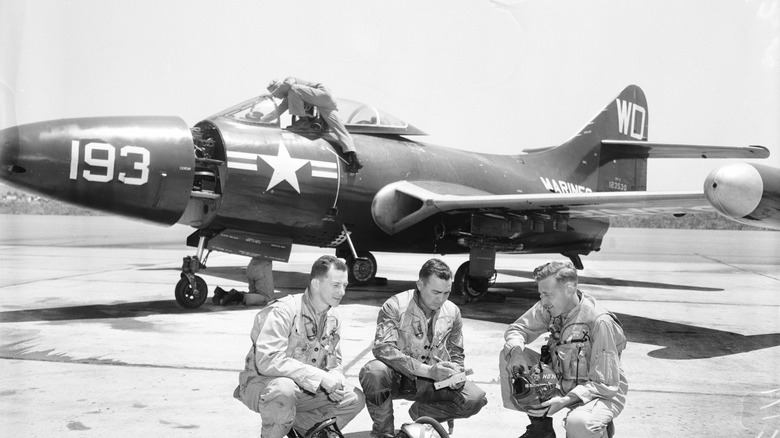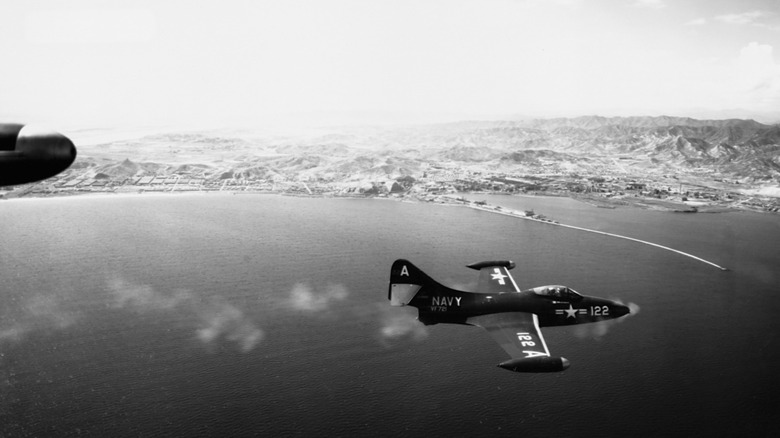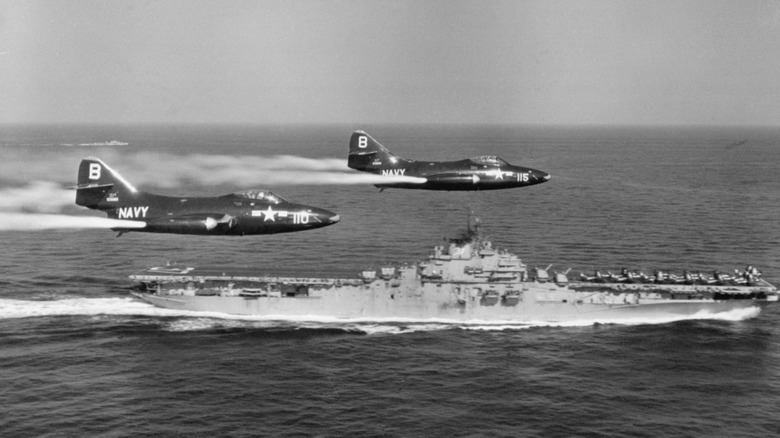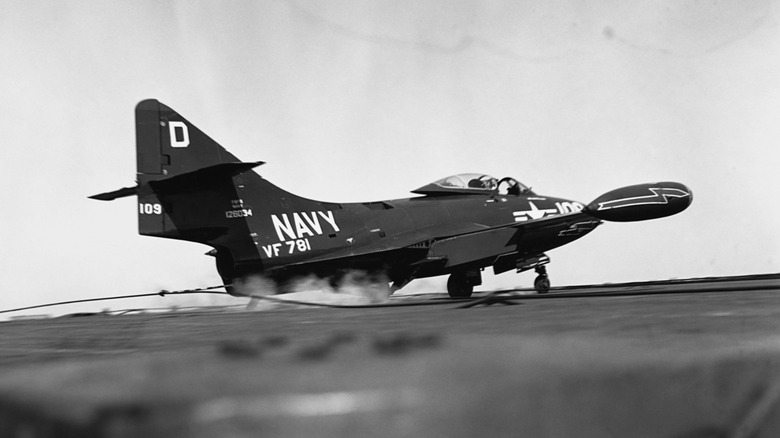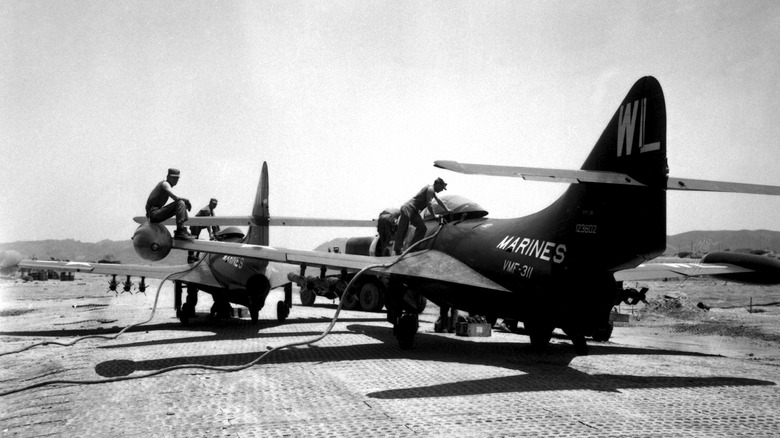Here's What Made The Grumman F9F Panther Jet So Unique
A critical component to American air superiority during the Korean War, the Grumman F9F Panther served as an important milestone in American military aeronautics. Shortly after WWII, American aircraft engineering took a giant leap forward as plane manufacturers and the U.S. military sought to replace the traditional piston engines used on previous military aircraft.
With the help of airplane manufacturers like Grumman, the Navy sought to create a viable jet-engine fighter that could take off and land on an aircraft carrier. Serving as one of the first jet-propelled planes for the Navy and Marines, the Grumman F9F Panther fighter jet was a capable carrier jet that was not only able to compete but eventually dominated the skies against arguably more competent Soviet aircraft.
Serving the American military to some degree until the mid-1960s, the Grumman F9F Panther was a massive step up in power and technology from its predecessors. While other, arguably more recognizable jets like the F-16 and F-4 are what come to mind when thinking of U.S. military fighter jets, those planes would have never existed if the F9F Panther hadn't paved the way.
A huge advancement in aeronautic technology
Research and development of the Grumman F9F Panther didn't go as smoothly as the Navy or Grumman anticipated. The airplane manufacturer obtained the contract to develop a jet plane capable of taking off and landing on an airplane carrier in April of 1946, but it wouldn't be until December 1949 that the first F9F Panther would take flight.
Initially, the contract awarded to Grumman was for the production of a fighter called the G-75, which was later designated the XF9F-1. The plane was a two-seat night fighter with wing-mounted turbojet engines. Four engines in total were required due to the comparatively weak power of jet engines in the mid-1940s, as engineers tested different configurations with the new technology.
Eventually, a shift in the project would lead Grumman to alter the program to develop a single-seat, single-jet day fighter. To do so, the company would equip the jets with Rolls-Royce Nene jet engines capable of generating 5,000 pounds of thrust. This new variation now held the designation of the XF9F-2 and would take its first flight on November 21, 1947.
Soon after, engineers would replace the Nene engine with an increased thrust version of the Alison J33 engine in the F9F-4 version of the plane, then finally with the Pratt & Whitney J48 variation of the Rolls-Royce Tay engine, which would become the F9F-5, the final designation for the Panther.
The F9F Panther had a successful combat history
By May of 1949, R&D for the F9F was finally complete, and the Navy's fighter squadron VF-51 was the first to receive the F9F-3 variant of the Panther. The Grumman F9F was the first carrier jet to fly in a successful combat mission for the United States Navy and Marine forces. This would occur in July of 1950 when Lieutenant Leonard H. Plog and Ensign E. W. Brown shot down two North Korean YAK-9s. The mission was the first time that Navy jet pilots downed enemy aircraft and served as the beginning of the military usage of the Panther.
Later that same year, an F9F Panther, piloted by William T. Amen, earned the first confirmed downing of a Soviet-piloted MiG-15. Over the remainder of the Korean War, Panthers were credited with shooting down 11 enemy aircraft while losing zero F9Fs in air-to-air combat.
The F9F-5s and F9F-2s would be the primary variations of the planes produced, with 1,385 jets delivered to the Navy by the end of production in 1953. By the end of the Korean War, most fighters on carrier decks were some derivative of the F9F. Though McDonnell FH-1 Phantom I holds the record as the first jet aircraft to take off from a U.S. aircraft carrier in 1946, only 60 of those planes would be produced, and the F9F would play a much greater role in the Korean War.
Famous pilots flew the F9F Panther
Among the earliest groups to receive the F9F Panther was the Blue Angels airplane flight exhibition team, which was formed in the 1940s by the Navy to drum up interest in the armed forces. The squad is still active and puts on some of the best airshows, performing high-flying aerobatic maneuvers to this day.
In 1949, the Blue Angels received the F9F-2 variation, which would serve as the team's first jet-propelled aircraft. The Blue Angels would continue to use some variation of the F9F until they switched in 1957 to the F11F Tiger, a successor to the Panther.
In addition to being used in high-flying stunt exhibitions, it might also be interesting to know that NASA pilots John Glenn and Neil Armstrong were also among two Panther pilots who flew during the Korean War — with Glenn earning the distinction as the third American in space, and Armstrong famously being the first person to walk on the moon.
The Grumman F9F Panther inspired modern jet-engine design
While indispensable during the later years of the conflict in Korea, the F9F Panther had a fairly short time as the primary carrier jet for the Navy and Marines. Navy fighter units retired their Panthers by 1956, with the Marines retiring the jets in 1958. The remaining jets would be transitioned to utility and trainer roles, with some portion of the jets serving as drone control aircraft through the mid-1960s.
Though only serving in a combat capacity for a few years, rapid advancements in jet-engine technology eventually caused the Grumman F9F Panther to become obsolete. The Panther would then be upgraded to the F9F-6 Cougar, the Navy's first swept-wing carrier-based jet fighter, followed by the F11F Tiger, which would be greatly overshadowed by two of the best fighters of all time, the F-8 Crusader and F-4 Phantom II.
Though the legacy of the F9F would be somewhat short-lived, the research and development that went into producing the craft provided crucial insights to aircraft engineers in some of the earliest jet-propelled planes ever. Though there were jet planes were developed before it, the Grumman F9F Panther was arguably the best to do it during its time.
